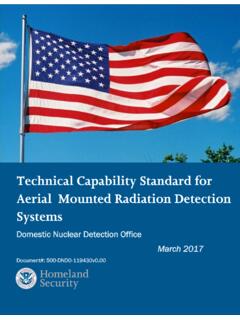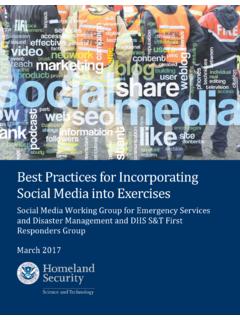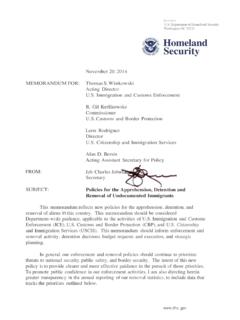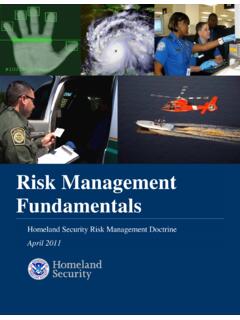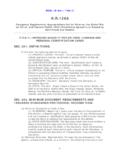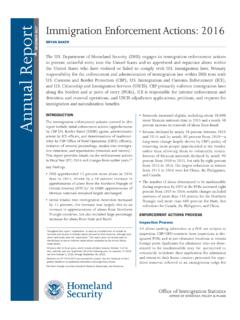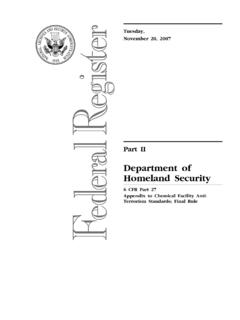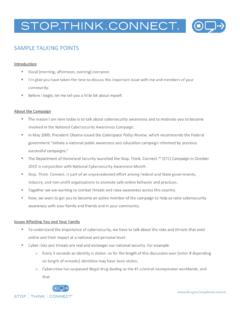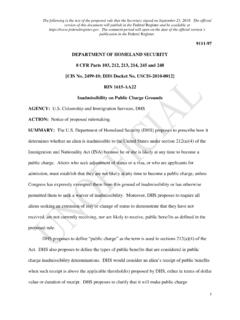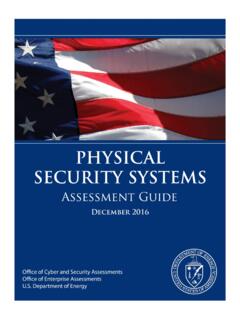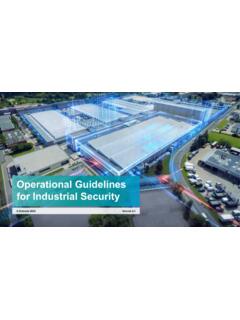Transcription of Voice over Internet Protocol (VoIP)
1 DHS 4300A Sensitive Systems HandbookAttachment Q5 To Handbook v. Voice over Internet Protocol (VoIP) Version December 22, 2014 Protecting the Information that Secures the Homeland DHS 4300A SENSITIVE SYSTEMS HANDBOOK ATTACHMENT Q5 Voice OVER IP This page intentionally blank , December 22, 2014 ii DHS 4300A SENSITIVE SYSTEMS HANDBOOK ATTACHMENT Q5 Voice OVER IP Document Change History Version Date Description HB version December 22, 2014 New document. , December 22, 2014 iii DHS 4300A SENSITIVE SYSTEMS HANDBOOK ATTACHMENT Q5 Voice OVER IP CONTENTS INTRODUCTION .. 1 Purpose and 1 VoIP Security Requirements Checklist .. 1 VoIP System 1 VoIP System Architecture.
2 1 Federal Guidance and Polices .. 2 THREAT OVERVIEW .. 3 VoIP Threats and Vulnerabilities .. 3 3 Network Vulnerabilities .. 4 Software Flaws and malware .. 4 Other Voice Service Related Threats .. 4 SECURING VoIP COMPONENTS .. 4 VoIP Security Mechanisms .. 5 Authentication .. 5 Virus Protection .. 5 Disabling Undesirable VoIP Features .. 5 Monitoring of System Configuration Change .. 5 SECURING VoIP 5 Voice and Data Separation .. 6 Data Protection .. 6 Firewalls .. 6 URL .. 6 6 Configuration Control .. 6 Physical Security .. 7 Security Assessment .. 7 Security Incident Response .. 7 Communication Service Convergence Unified Communications.
3 7 , December 22, 2014 iv DHS 4300A SENSITIVE SYSTEMS HANDBOOK ATTACHMENT Q5 Voice OVER IP Appendix A: Checklist for Securing VoIP Systems .. 9 Appendix B: Referenced Publications .. 12 Appendix C: Acronyms and Definitions .. 13 , December 22, 2014 v DHS 4300A SENSITIVE SYSTEMS HANDBOOK ATTACHMENT Q5 Voice OVER IP INTRODUCTION This document provides techniques and procedures for the secure use of Voice over Internet Protocol (VoIP) within the Department of Homeland Security (DHS) Information Technology (IT) Program. It is published as an Attachment to the DHS 4300A Sensitive Systems Handbook, which is based on DHS Sensitive Systems Policy Directive 4300A. DHS Components should use the guidance in this Handbook Attachment as a foundation for developing and implementing VoIP IT related security programs.
4 This Attachment incorporates many security techniques and procedures already in use by DHS Components and other Federal entities such as the National Institute of Standards and Technology (NIST), the Department of Defense (DoD), and communication standardization organizations; and general VoIP security best practices commonly recommended and followed by private industry and academic communities. Purpose and Scope guidance outlined in this document is intended to address security policy requirements pertinent to VoIP, and to provide a detailed explanation of security threats and corresponding countermeasures that can be applied to VoIP systems deployed by DHS Components. The security checklist in Appendix A provides a summary of VoIP security guidelines.
5 Authorizing Officials (AO) should understand the risks associated with each particular VoIP system, and apply some or all of the countermeasures outlined in this Attachment. They should ensure that each risk is measured and mitigated to an acceptable level according to DHS IT security policies defined by the DHS Sensitive Systems Policy Directive 4300A and other related directives. VoIP Security Requirements Checklist the Security Requirements Checklist for VoIP Systems, Appendix A to this document, to ensure Component compliance with Policy Directive 4300A and with underlying Government directives. The Checklist items identified as Required must be implemented by Component policies, SOPs, or other methodological documents; furthermore, implementation of the items identified as Recommended or equivalent provisions, will ensure that Components are compliant with best security practices.
6 VOIP SYSTEM OVERVIEW This section gives a brief introduction of VoIP system architecture and technologies in an enterprise environment, and provides a high-level summary of Federal guidance and policies for VoIP systems. VoIP System Architecture is a technology that converts Voice into digital data packets that are transmitted over IP data networks such as enterprise networks or the Internet . VoIP is a mature technology that has been widely deployed across public and private sectors since it uses existing IP data network infrastructure, , December 22, 2014 1 DHS 4300A SENSITIVE SYSTEMS HANDBOOK ATTACHMENT Q5 Voice OVER IP eliminating expensive traditional dedicated Voice circuits. The following diagram describes typical enterprise VoIP system architecture and key system components.
7 Figure 1: Enterprise VoIP System Architecture . The VoIP server is the control and management hub of all VoIP components. It is responsible for VoIP call session management, Voice mail management, directory assistance, and other additional services such as conference bridge. The gateway is connected to telephone service providers Public Switched Telephone Networks (PSTN), and is the bridge between the internal VoIP system and general PSTN: all calls to or from outside telephone numbers go through the gateway. In addition to VoIP telephone instrument hardware, VoIP softphones are widely deployed. A VoIP softphone is a computer program that runs on desktop or laptop computers, mobile devices etc.
8 , allowing users to make VoIP calls through those devices. Federal Guidance and Polices Federal Communications Commission (FCC) requires VoIP systems to support enhanced 911 (E911) emergency services that provide caller identification and location information to the answering Public Safety Answering Point (PSAP). NIST Special Publication 800-58, "Security Considerations for Voice over IP Systems, provides agencies with guidance for establishing secure VoIP networks and makes several recommendations to establish a secure VoIP and data network. Key recommendations are as follows: , December 22, 2014 2 DHS 4300A SENSITIVE SYSTEMS HANDBOOK ATTACHMENT Q5 Voice OVER IP Develop appropriate network architecture.
9 Ensure that the organization has examined and can acceptably manage and mitigate the risks to their information, system operations, and continuity of essential operations when deploying VoIP systems. Carefully consider such issues as level of knowledge and training in the technology; maturity and quality of security practices; controls, policies, and architectures; and understanding of associated security risks. Be aware that physical controls are especially important in a VoIP environment and deploy them accordingly. Enable, use, and routinely test the security features that are included in VoIP systems. Deploy VoIP-ready firewalls and other appropriate protection mechanisms. If mobile units are to be integrated with the VoIP system, use products that implement Wi-Fi Protected Access (WPA), rather than Wired Equivalent Privacy (WEP).
10 Carefully review statutory requirements regarding privacy and record retention with competent legal advisors. THREAT OVERVIEW This section discusses VoIP threats and vulnerabilities in an enterprise environment, and outlines corresponding countermeasures and security best practices. VoIP Threats and Vulnerabilities systems are vulnerable to specifically engineered attacks as well as to general network attacks. VoIP is fundamentally different from the traditional circuit-based telephony, and these differences introduce significant security threats and vulnerabilities. A VoIP system is part of the overall enterprise IT infrastructure and is directly connected to the enterprise core IP network.
